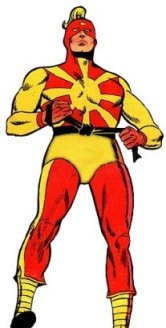Saturday, March 25, 2017
The Howlers - Fangs Of The Fox!
The sixth issue of Sgt.Fury and the Howling Commandos brought the realities of war front and center when the fictional Howlers are ordered to capture Field Marshal Erwin Rommel, the notorious Nazi war leader dubbed "The Desert Fox". It's a potent story by Stan Lee with exquisite artwork by Jack Kirby and George Roussos (Bell). It's also a story which speaks directly to bigotry and racism, something comic books were only beginning to address in 1964.
The Howlers lose the services of Private Dino Manelli, their resident actor and fluent German speaker. His replacement is a name named Stoneman who comes across strangely when introduced to the Italian-American Manelli and the Jewish-American Izzy Cohen. But when he meets African-American Gabe Jones his bigoted attitudes erupt and he is put on notice by Nick Fury that such nonsense will not be tolerate inside the Howlers. The team, still smarting somewhat from the dust up head of to the deserts of North Africa complete their nearly impossible mission to capture the notorious Rommel. They find some help from local Arab nomads and eventually locate Rommel's camp. Against nearly impossible odds they sneak into Rommel's camp but the plan is upset when Stoneman's racism precludes him working with Cohen or Jones and he ends up creating a firefight. The Howlers escape with their lives barely and Stoneman is saved first by Izzy who carries him off the battlefield and later by Gabe when his rare blood is the only match for the racist soldier. The Howling Commandos are disappointed they failed in their mission but heartened when they learn that their mission had been cancelled soon after they left because it became known that Rommel was part of a secret plot to kill Hitler. The Howlers dismiss Stoneman quickly when they return to base but some clues indicate he might have learned something from his interaction with the team, but it's suggested that such bigotry takes time to recover from.
The forward thinking evident in this story was no inconsiderable improvement for a comic book industry which has a tough history with portraying race. Even the earliest issues of this comic itself foundered in regard to this as the debut issue actually failed to show Gabe as a black man on the interior, though this was corrected in reprints. But as it turns out it was the military which in the late 1940's under Harry Truman did lead the way to eventual desegregation throughout a reluctant nation with the an order to desegregate its own forces going forward. The team portrayed in Marvel's comic was not possible in the war itself. This country's greatest shame is its ongoing fundamental racism which continues to permeate the society in all sorts of ways even though its legal foundations have long been struck down. We can only hope books like Sgt. Fury helped in some small measure to lead the way.
More to come.
Rip Off
Labels:
George Bell,
George Roussos,
Jack Kirby,
Marvel Comics,
Nick Fury,
Stan Lee,
War Comics
Subscribe to:
Post Comments (Atom)





Great comic and analysis, Rip!
ReplyDeleteOne note: I think military desegregation under Truman would've been in the late 40s, rather than the late 50s.
Thanks for the correction. I have made the requisite changes to the post. Sigh, those pesky things called facts.
DeleteRip Off
This brings to mind Fury #45, "The War Lover", one of Severin's first issues in which he was still both penciller and inker, and obviously had a lot to do with the brilliant story structure, which blends some pretty intense psychological drama with a wonderful running gag about Dum-Dum. The main character is a guy who has become so twisted by his need for his father's approval that he has mutated from a human being capable of compassion to a fanatic who kills almost reflexively in the name of patriotism, without any regard for his fellow soldiers. It's still a powerful story, but it had quite an impact at the time it appeared, which was during the Vietnam war.
ReplyDeleteI'm guilty of this too, but clearly war comics have been ignored or perhaps more accurately overshadowed by their superhero counterparts. The realities explored in them is significant and important to young readers and how they apprehend the world.
DeleteRip Off